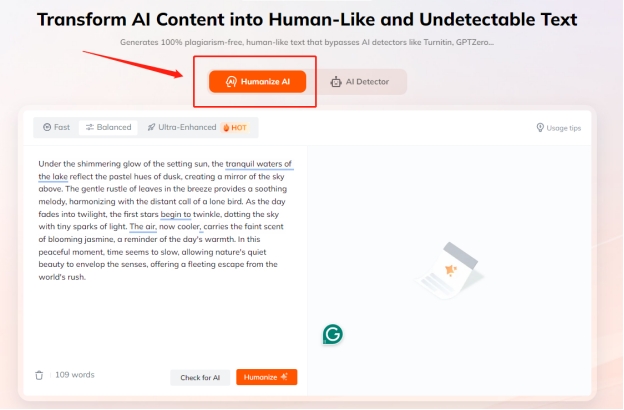How to Make AI Sound More Human: A Guide for Content Creators
Imagine pouring hours into an article, only to have it flagged as AI-generated. With businesses and educational institutions increasingly using AI detectors, ensuring the originality of written work has never been more critical. These advanced tools scrutinize text for patterns characteristic of AI-generated content, putting pressure on writers how to humanize ai content that resonate on a human level.
In the sections ahead, we’ll delve into the reasons why content may be flagged as AI-generated, explore effective strategies how to make ai sound more human, and highlight valuable tools to help achieve this goal.
Catalogs:
Why was my content marked as AI-generated?
When content is flagged as AI-generated, it can be disheartening for writers who invest time and effort into their work. Understanding the reasons behind these designations can help creators adjust their approach. Here are some common reasons why content may be marked as AI-generated:
-
Lack of Personalization : Content generated by AI may lack the unique voice and personal touch that human writing often carries. This can lead to detection by AI tools.
-
Repetitive Patterns : AI writing tends to follow certain patterns or structures that can be easily recognized by detection software, marking it as non-human.
-
Overly Formal Language : AI-generated content often adopts a formal tone that can sound robotic, which detectors are trained to identify.
-
Limited Creativity : AI may struggle with creative expressions or nuanced ideas, making the content sound generic and flagged.
How to make ai sound more human?
To help AI-generated content resonate better with readers, here are several effective methods that writers can use. The table below summarizes these methods:
| Method | Summary |
|---|---|
| Bypass Tool | Use tools like Tenorshare AI Bypass to enhance the naturalness of AI-generated content. |
| Personalization | Infuse personal anecdotes or experiences to give a unique touch. |
| Varied Sentence Structures | Incorporate a mix of short and long sentences to mimic natural speech patterns. |
| Emotive Language | Use emotionally charged words to connect with the audience on a deeper level. |
| Colloquial Expressions | Integrate casual language or slang to create a more relatable tone. |
| Creative Analogies | Employ unique metaphors or similes to illustrate ideas vividly. |
| Diverse Vocabulary | Utilize synonyms and varied word choices to avoid repetition and enhance engagement. |
How to Make AI Sound More Human Using an AI Bypasser?
One of the most effective tools available to enhance AI-generated content is Tenorshare AI Bypass . This innovative software enables users to modify text output seamlessly, making it sound more natural and human-like. By altering syntax, structure, and vocabulary, this ai humanizer empowers writers to refine their AI-generated drafts and mitigate the risk of detection.
-
You just need to Paste AI Text into Tenorshare AI Bypass.

-
Click "Humanize" to Humanize AI Text and then you will get undetectable output

How to Make AI Sound More Human with Personalization?
To learn how to make AI writing sound more human, add personal stories or insights. Genuine experiences engage readers and create a connection that AI-generated content often lacks.
Example: Instead of stating a general fact, share a personal story, like how a diet change improved your health, making the content more relatable and engaging.
How to Make AI Sound More Human with Varied Sentence Structures?
Utilizing a mix of short, punchy sentences and longer, more complex ones can create a natural rhythm in your writing. This variation mirrors how people communicate in everyday conversations, enhancing engagement.
Example: Start with a punchy statement, then expand: “Social media has changed everything. It’s now about sharing experiences and building communities.”
How to Make AI Sound More Human with Emotive Language?
Using emotionally charged words makes AI writing more relatable and engaging.
Example: Instead of saying, “The movie was good,” try, “The movie left me exhilarated and wanting more.” This draws readers into the emotional experience.
How to Make AI Sound More Human with Colloquial Expressions?
Incorporating everyday language, idioms, and informal phrases helps create a conversational tone that resonates with readers. This familiarity makes the writing feel approachable and relatable.
Example: Rather than saying, “Let us begin our discussion,” try using, “Let’s dive into this!”
How to Make AI Sound More Human with Creative Analogies?
Employing unique metaphors or similes can vividly illustrate complex ideas and enhance the reader's understanding. Creative analogies make writing more colorful and make writing sound less ai.
Example: Instead of a straightforward statement, use a metaphor: “Navigating through life’s challenges is like sailing in uncharted waters; every wave brings a new adventure.”
How to Make AI Sound More Human with Diverse Vocabulary?
Utilizing a broad vocabulary can keep your writing fresh and engaging, avoiding the pitfalls of repetitiveness that often characterize AI-generated content. A diverse range of word choices enhances clarity and keeps readers interested.
Example: Instead of repeatedly using “good,” explore alternatives like “fantastic,” “remarkable,” or “impressive.”
Pro Tip:
If you are looking for ai commands for essays to make it sound more realistic then you can use this prompt:
"Generate an essay on [topic] that includes emotive language, personal anecdotes, vivid descriptions, and a conversational tone. Use varied sentence structures to enhance readability and ensure the content feels authentic and relatable to engage the audience effectively."
Conclusion
Tenorshare AI Bypass is a powerful tool to make writing sound less AI and connect more authentically with readers. By applying the methods discussed, you can bring personality and emotional depth to your text, transforming AI content into something more engaging and relatable. In today’s world, authenticity is crucial, and learning to humanize your writing helps improve its quality while building a deeper connection with your audience. Feel free to share your experiences and favorite techniques in the comments!



